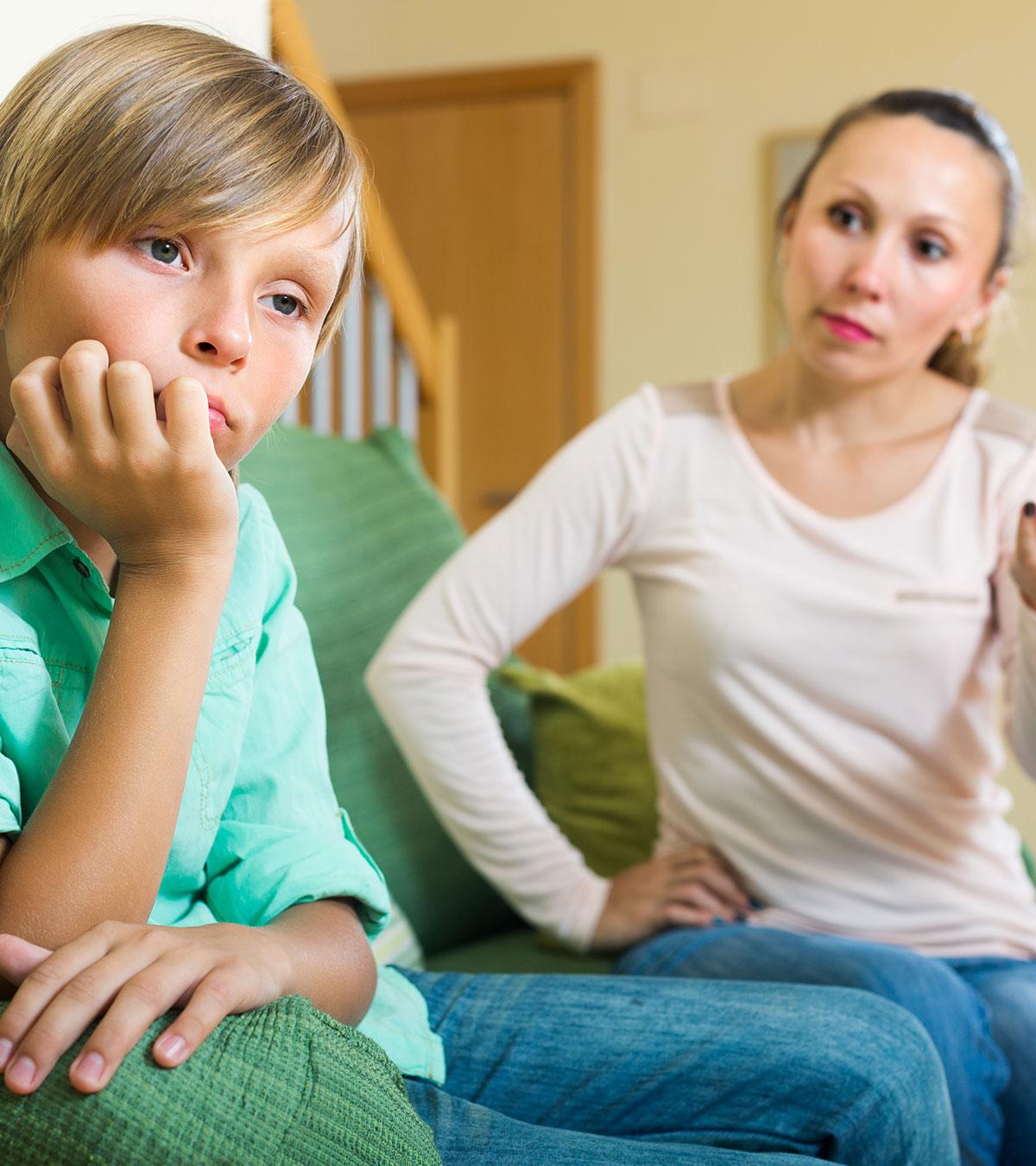
Shutterstock
Positive reinforcement for kids is a research-backed practice used to support and encourage children to use their skills and behavior (1). Learning often results from rewards or praising words and consequences or punishments (2). The practice of positive reinforcement focuses on appreciating the child’s good behavior and acknowledging efforts rather than punishing them for their mistakes. It is proven to be an effective behavior modification strategy for children and people across age groups and animals (3). This practice can promote consistent good behavior and favorable outcomes in children.
Read about the technique, its benefits, examples, and an exhaustive list of words you can add to your vocabulary for positive reinforcement in your children.
Key Pointers
- Positive reinforcement for kids focuses on appreciating and encouraging good behavior instead of punishing or scolding them for their bad behavior.
- Remain consistent in rewarding a child’s behavior to yield the best results.
- Natural, social, and activity reinforcers are better than token or tangible reinforcers in the longer run.
How Positive Reinforcement Works
Image: Shutterstock
Appreciating your child’s right behavior with appropriate rewards and recognition helps positively reinforce good behavior. Since undisciplined behavior is easier to notice, one should consciously focus on the child’s appropriate behavior while ignoring the inappropriate behavior for the desired results (4). You should pick a reward that your child would like, value, and enjoy.
It is a common misconception that if you give attention to or praise them or give compliments for their good deeds, they may begin to misbehave. However, research proves otherwise (4). The inappropriate behavior increases and strengthens by adults’ words, attention, and action. There is a basic law of life that suggests that what we focus on we amplify.
Your kind words, gestures, cheers, appreciation, acknowledgement and positive feedback can help reinforce good behavior in your children. You may initially give a reward every time they do a good deed. Gradually, you may decrease rewarding every time to alternate times before moving to occasional rewarding and then stopping it entirely once the behavior becomes a habit (2).
Lindsay Heckmann, an early childhood educator and blogger, shares her unique approach to positive reinforcements for her students. She uses something called ‘happy point stickers’ to encourage good behavior. Heckmann narrates, “I tell the students what I expect of them and tell them there are happy point stickers at stake to those who abide. I distribute happy point stickers while thanking them for their positive behavior, which I want to reinforce when the task is completed. Should a student exhibit negative behavior, I remind them verbally as a class of the happy point stickers at the end and try to point out the positive behavior I see in the classroom… Should a student do something very wrong (i.e. hitting, spitting, etc.), I have them remove the sticker from their chart and explain to me why they had to do so.
“When a student has obtained all 25 of their stickers, they are able to choose a prize (thanks, mom) from the prize bag. I am more than confident that even without the prizes, this method would work (i).”
Benefits Of Positive Reinforcement For Children
The following are the possible benefits of positive reinforcement for children.
1. Verbal affirmation works better
Children feel loved and noticed when they are appreciated for the small good things. Simple sentences such as “I love how you put your toys back on the shelf” can inspire the child to do things that would please you more. These positive words of encouragement for kids give them validation and a sense of self-worth. It also helps you build a stronger bond with your child (5).
 Point to consider
Point to consider2. Helps boost their self-confidence
Image: Shutterstock
Consequences and punishment can make your child think they are wrong. On the contrary, positive reinforcement and kudos boost their self-esteem and self-belief. It makes them feel worthy and significant.
3. Supports character development
Positive reinforcement helps in character building as it has several long-term benefits. Trying to change your child’s behavior by instilling fear of punishment can result in negative feelings even when they grow up. Getting rewards for their good deeds such as showing gratitude and empathy can make them responsible for an act.
4. Helps make behavioral choices
Parental approval and encouragement help children make correct decisions. It can help parents instill positive behavior in children and enable them to pick good over evil. The probability of getting applauded will push them to do right and encourage them to engage positively with peers.
5. Stimulates internal motivation
Instead of thinking that they will be punished, the thoughts of getting rewards for good behavior stimulate enthusiasm and intrinsic motivation in children. It reduces the need for parental monitoring of everything a child does and allows them to be responsible for making the right choices.
Types Of Reinforcers
If you are wondering how to discipline your child, here are some common reinforcers depending on the situation and the child (6):
- Natural reinforcers arise directly from the results attained with proper behavior. For example, a student who studies hard pays attention in class, asks questions, completes assignments in time, and scores well in examinations. Good scores act as natural reinforcers for the child to do better.
- Social reinforcers are mediated by teachers, coaches, parents, or other adults in the form of appreciation or approval for good behavior. Behavioral or verbal appreciation by people around them can encourage children to behave well.
- Tangible reinforcers include rewarding money, gifts, toys, stickers, balloons, etc., or edibles such as candies and Jell-O. However, it is essential to monitor the use of these reinforcements as they can be unhealthy or set a wrong precedent.
 Point to consider
Point to considerImage: Shutterstock
- Token reinforcers are virtual points or credits. Children can be motivated to collect some points and exchange them for something they desire.
- Activity reinforcers could be practical and positive for children. On performing a good deed, you can reward them with additional time for the desired activity, such as playtime, computer time, swimming, and screen time.
Examples Of Positive Reinforcement
Apart from token reinforcers, activity reinforcers, and tangible reinforcers, you can positively reinforce a child’s behavior in the following ways (7). These are inexpensive or even free.
- Offering a simple smile
- Praising them
- Telling others about how proud you feel about your child, in the child’s presence
- Giving a high five
Image: Shutterstock
- Giving a pat on the back
- Giving a thumbs up to them
- Clapping for them
- Cheering them up
- Giving them a hug
- Having your special victory dance
- A star chart (can work well for younger children)
Examples Of Behaviors To Reinforce
The behaviors you would want to reinforce in your child may differ from family to family and are as follows:
- Good manners
- Playing quietly
- Waiting patiently
- Playing harmoniously with a sibling or a friend
Image: Shutterstock
- Co-operating with the parents’ requests and house rules
- Completing all chore
- Working hard to accomplish a difficult task
It’s important to be very specific and factual when praising for it to be effective. Children can sense fake praise.
Difference Between Positive And Negative Reinforcement
Positive reinforcements are words or actions to encourage a positive behavior in children. On the other hand, negative reinforcements are tactics used to prevent your child from repeating bad behavior. In positive reinforcement, you reward your child with treats or words of encouragement for completing a task or doing something good. On the flip side, negative reinforcement includes removing a privilege or taking away something from your child for a bad deed. Positive reinforcement focuses on encouraging good behavior using rewards. In contrast, negative reinforcement prompts children not to repeat the same mistakes. Both actions play a role in shaping your child’s behaviors, leading to behavioral change.
Frequently Asked Questions
1. How can I implement positive reinforcement?
One of the best ways to implement positive reinforcement is by offering actionable advice. To do this, set clear boundaries for acceptable behavior and create a reward chart to track your child’s progress. Additionally, provide immediate feedback to avoid any confusion and reinforce positive behavior.
2. How can positive reinforcement help children with ADHD or other behavioral challenges?
Positive reinforcement can help children with ADHD or other behavioral challenges by giving them praise, attention, and rewards when they exhibit positive behaviors. This can motivate them to continue displaying positive behaviors, which can help them develop new habits and overcome challenging behaviors. Effective teachers and parents practice frequent praise and appreciation before completing tasks (8).
3. Can positive reinforcement encourage healthy habits, such as exercise and healthy eating?
Positive reinforcement can encourage healthy habits, including exercise and a balanced diet. For example, a study showed that more positive reinforcement and less controlling parental styles significantly impacted children’s health behaviors (9). This can motivate children to continue engaging in these habits and help them develop healthy habits that will benefit them throughout their lives.
4. Is it possible to overuse positive reinforcement with children, and if so, what are the consequences?
Overusing positive reinforcements as bribes or incentives can lead to a dependency on rewards, resulting in children only engaging in positive behaviors when they know they will receive a reward (10). This can limit a child’s ability to develop internal motivation, resulting in decreased self-esteem and confidence.
5. Can positive reinforcement improve a child’s academic performance?
By providing praise, attention, and rewards combined with non-verbal reinforcement for academic achievements and positive behaviors related to learning, children can be motivated to continue displaying these behaviors, which can lead to improved academic performance (11).
6. How can parents balance positive reinforcement and discipline when parenting their children?
Parents can balance positive reinforcement and discipline when parenting their children by clearly understanding the expectations and consequences for positive and negative behaviors for both the parent and child. It is essential to offer parental understanding by acknowledging the child’s feelings and communicating the limits when they exhibit negative behaviors instead of resorting to punishment or negative reinforcement. Using positive reinforcement to encourage positive behaviors and discipline to discourage negative behaviors can help parents achieve a balance (12).
Positive reinforcement for kids can make them disciplined, righteous, and confident in childhood and as they grow older. It will also improve the bond between the parent and the child. Once you begin to notice positive reinforcement results, you will feel that your home is a happier place. Moreover, as you get more involved in the practice, you will be a better parent. If all caregivers or family members follow a similar reinforcement pattern, the results could be sooner, and you will find that positive reinforcers work better than punishments for kids.
Infographic: Advantages Of Positive Reinforcement For Children
Being a parent has its own challenges, as you always have to look for ways to discipline your children without being rude. Positive reinforcement is one strategy that can help children be better without parents resorting to punishments. The following infographic explains how positive reinforcement benefits a child’s life.
Illustration: Momjunction Design Team
Illustration: Positive Reinforcement For Children: Types Benefits And Examples
Image: Stable Diffusion/MomJunction Design Team
Providing positive feedback to children encourages the habitual desired behaviors. This video demonstrates how positive reinforcement can help shape children’s behavior.
Personal Experience: Source
MomJunction articles include first-hand experiences to provide you with better insights through real-life narratives. Here are the sources of personal accounts referenced in this article.
i. Positive reinforcement for kindergarten students in a Korean Hagwon;https://medium.com/@lindsay.heckmann/positive-reinforcement-for-kindergarten-students-in-a-korean-hagwon-44ef63b1e221
References
- Jessica K. Hardy; Using Positive Reinforcement With Young Children.
https://experts.illinois.edu/en/publications/using-positive-reinforcement-with-young-children-2 - Changing Behavior with Positive Reinforcement.
https://hhma.org/healthadvisor/aha-behav-bha/ - Why Positive Reinforcement Works for Students.
https://owis.org/sg/blog/why-positive-reinforcement-works-for-students - Ellen A. Sigler, and Shirley Aamidor; (2005); From Positive Reinforcement to Positive Behaviors: An Everyday Guide for the Practitioner.
https://static1.squarespace.com/static/53595601e4b0c9059ae8bd3e/t/5e6e749c50eead5473dc3479/1584297118075/2005_-_Ellen_A_Sigler_-_FromPositiveReinforcementtoPositiveBehaviorsAnEver.pdf - How to Use Positive Reinforcement for Children.
https://www.newkidscenter.org/Positive-Reinforcement-for-Children.html - Positive Reinforcement… a proactive intervention for the classroom.
https://ceed.umn.edu/wp-content/uploads/2017/05/Positive-Reinforcement.pdf - FACT SHEET – REINFORCEMENT.
https://www.fau.edu/education/centersandprograms/card/documents/reinforcement.pdf - 5 Effective Positive Reinforcement Tips for Your Child with ADHD)
https://chadd.org/adhd-weekly/5-effective-positive-reinforcement-tips-for-your-child-with-adhd/ - Elva M. Arredondo et al.; (2006); Is parenting style related to children’s healthy eating and physical activity in Latino families?
https://academic.oup.com/her/article/21/6/862/609279 - Kareen Smith; Positive Reinforcement… a proactive intervention for the classroom.
https://www.acealabama.org/uploads/9/5/5/2/95521332/positive_reinforcement_in_the_classroom.pdf - T Sumiati et al.; (2019); Building children’s learning motivation through positive reinforcement in science and math classroom
https://iopscience.iop.org/article/10.1088/1742-6596/1318/1/012023/meta - Discipline and Finding Your Balance as a Parent
https://www.sanctuarycounselinggroup.org/perspectives/discipline-and-finding-your-balance-as-a-parent
Community Experiences
Join the conversation and become a part of our nurturing community! Share your stories, experiences, and insights to connect with fellow parents.
Read full bio of Angela Karanja
Read full bio of Dr. Ritika Shah
Read full bio of Harshita Makvana
Read full bio of Apoorva K




























